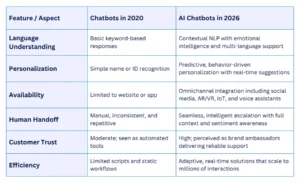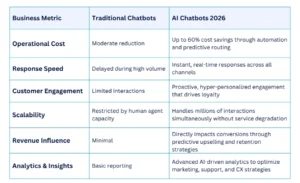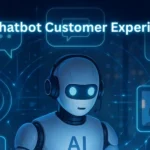The customer experience of AI chatbot will cease to be an aid device in 2026 it will be the backbone of how businesses will interact with their customers. With the outlook of the customers changing to be instant and customized alongside being omnichannel, companies are considering AI-powered chatbots to provide proactive, intelligent, and emotionally aware customer support. AI chatbots are reinventing industries such as e-commerce, finance, healthcare, and travel through hyper-personalized recommendations, intelligent human handoffs, and more. Companies that use AI in customer service are not just improving customer experience, but are also achieving quantifiable growth and productivity.
Why AI Chatbots Will Dominate Customer Experience in 2026
The demands of customers have shifted away from focusing on straightforward query solutions and towards experiences that are hyper-personalized, available 24/7, and the AI chatbot customer experience has become the center of this change. By 2026, businesses will have outgrown mere automation and will have AI chatbots with advanced conversational intelligence to provide real-time personalization, emotional insight, and flawless omnichannel interaction.
What’s driving the massive adoption of AI chatbots in 2026?
- Next-generation Generative AI that allows people to talk to each other naturally and naturally, with an unparalleled contextual memory and a tone that adapts.
- 40-60% support costs will be reduced because AI chatbots will address repetitive questions that human agents addressed in the past.
- Omnichannel AI chatbots were all integrated on websites, mobile apps, WhatsApp, social media, and immersive AR/VR environments.
- Scalability Infinite; AI chatbots for customer support can accommodate millions of interactions in real-time without delays and burnout.
Customer service AI is no longer a question of efficiency – by 2026, it will be the strategic driver of customer experience change fueled by intelligence, empathy, and scale.
Evolution of AI Chatbots: 2020 vs. 2026

How AI Chatbots Are Redefining Customer Experience in 2026
In 2026, AI chatbot customer experience will not be restricted to solving simple queries. By 2026, AI chatbots will become smart digital assistants that will be proactive in helping customers, predict their needs, and provide them with personalized experiences in various channels. Companies that use AI to enhance customer service can now transform AI and optimize customer experience, engage more, and compress the cost of operations, as well as expand support to customers worldwide.
1. Hyper-Personalized Interactions Through Predictive Intelligence
Chatbots based on AI are leaving preset scripts. Using high-level predictive analytics, an AI chatbot customer experience can process customer history, previous purchases, browsing behavior, and even contextual data such as time, location, or seasonal trends. This enables chatbots to offer very personalized real-time suggestions.
Example: An AI chatbot in 2026 can be used in e-commerce to suggest clothing, not only depending on previous purchases, but also based on upcoming events, weather forecasts of where the user is located, and the current fashion trends. Likewise, a travel booking chatbot will forecast the likelihood of an individual booking business or leisure travel and propose add-on services like insurance, hotel upgrades, or custom tours automatically.
Benefit: This type of AI personalization in customer service enhances the interaction of the service, conversion, and loyalty to the brand, as every communication will be personal and human. The outcome will be a more AI chatbot customer experience that transcends transactional assistance to form particular value-based experiences.
2. Multilingual, Multicultural, and Emotionally Intelligent Conversations
The contemporary AI chatbots 2026 are constructed in a global-access manner. In contrast with older models that only supported the English language or a handful of languages, modern AI chatbots 2026 can hold a conversation in 150+ languages. Moreover, it can also comprehend cultural details and emotions. AI chatbot customer experience enables companies to grow worldwide without having to hire more human support teams.
Example: A banking chatbot communicating with a customer in Brazil can identify when the customer is frustrated, deliver empathetic replies, and select Portuguese or English as a language, regardless of when a customer requires it, and keep the context of prior interactions in place. In the meantime, a chatbot as a retailer may modify the level of humor, idioms, or politeness based on the local culture.
Impact: With conversational AI 2026, brands are more inclusive, more accessible, and more trusted. Omnichannel AI chatbots also decrease response time, raise customer satisfaction, and facilitate omnichannel AI chatbot approaches, which cross websites, applications, messaging platforms, and social media.
3. Seamless Human Handoffs with Zero Friction
AI chatbot customer experience no longer work in isolation from human agents. Sophisticated systems will be able to discern complicated questions or emotions with high intensity through sentiment analysis and automatically ramp up the dialogue – without losing context.
Scenario: A customer who is angry and calls a telecom company due to a network failure will be redirected to a live operator, and the chatbot will give a detailed report of the conversation, including the history of the previous services. The customer will not have to repeat himself/herself, which will guarantee efficiency and emotional gratification.
Advantage: This smart escalation allows businesses to keep customer service at a high quality and uses AI in customer service to decrease the number of human workers. By having AI effectiveness with human empathy, corporations can provide a better AI chatbot customer experience, which can be extended worldwide.
4. Proactive Engagement That Anticipates Needs
By 2026, AI chatbot customer experience will not be based on a reactive mode of problem-solving but on proactive interaction. They track user behavior, buying patterns, and service touchpoints to start a conversation at the appropriate time, which means less friction, more satisfaction.
Example Use Cases:
- The cart has been left pro bono – chatbot will provide a dedicated offer.
- Subs that are about to expire – chatbot provides individual upgrade plans.
- Service disruption identified – Chatbots powered by AI will automatically inform customers that they are in contact with the service desk.
Through pre-employment, AI chatbot customer experience establishes a transformation that will help businesses remain a step ahead of customer levels of expectations. This proactive strategy also expands retention, churn, and leads to quantifiable ROI.
5. Integration with Emerging Technologies for a Future-Ready Experience
In 2026, AI chatbots will stop working in isolation. They will be able to blend with the new technologies like voice assistants, augmented reality (AR), and IoT gadgets, and provide a truly omnichannel AI chatbot customer experience.
Example:
- Voice-activated AI virtual assistants 2026 will take the place of apps, allowing customers to interact with them hands-free.
- In AR-powered chatbots, users can virtually try products, receive an immersive shopping experience, or simply see how their home would look before buying it.
- Connected AI chatbots in smart appliances, including fridges and cars, will alert the user about maintenance, inventory, or reordering, predicting user requirements without human intervention.
Business Value: The integrations make AI chatbots 2026 at the heart of digital transformation plans. The companies that engage an AI development company such as AnavClouds Analytics.ai will be able to install these AI-powered chatbots to optimize operations, save money, and improve the overall AI chatbot customer experience.
AI Chatbots 2026: Business Benefits & Impact

How Will AI Chatbots Transform Different Industries in 2026?
The future of AI chatbots 2026 goes beyond the generic customer service and is fundamentally changing the customer experience in any industry, through hyper-personalization, real-time problem-solving, and a flawless experience. We should analyze the impact of AI chatbot customer experience on major sectors in the years to come.
E-Commerce
AI chatbot customer experience in e-commerce is developing into virtual shopping assistants, which can suggest products in advance and provide real-time advice.
- Personalized Product Suggestions: AI chatbots can be used to recommend products based on how one browses, what they have already bought, and what is popular at the moment.
- Immediate Credits and Track of Order: Orders are auto-refunded and improving satisfaction and retention.
- AR-Based Virtual Assistants: AR-enabled shopper chatbots allow the customer to virtually try on items, which makes the purchasing process more immersive and interactive.
AI chatbot customer experience will result in the online shopping process being intuitive, fast, and highly engaging.
Banking & Finance
Finance Fintech is using AI chatbots to provide secure, real-time, and smart services:
Fraud Detection Notifications: AI chatbots are programs that watch over transactions in real-time and alleviate customers to unusual activity.
- Loan Eligibility Checks: Chatbots can examine loan applications and grant approvals or recommendations to them instantly.
- 24/7 Investment and Advisory Bots: AI chatbots will give one personalized advice on investments, Portfolio updates, and market insights at any time.
- Having an AI chatbot customer experience in the banking sector, the institutions decrease the rate of human mistakes, enhance trust, and provide the most personalized financial advice.
Healthcare
Conversational AI will be integrated into healthcare in an attempt to streamline the process as well as provide more interactive engagement with the patient:
- Symptom Checkers: AI chatbots make use of a wide range of medical databases in a bid to provide preliminary assessments, redirect patients toward new choices.
- Appointment Scheduling and Reminders: Patients can book appointments, get reminders, and manage prescription refills using artificial intelligence chatbots.
- Mental Health Support: AI chatbots deliver timely emotional support, coping strategies, and crisis intervention tools to supplement human care.
By 2026, AI chatbots in healthcare customer experience will lessen the administrative burden and improve access and outcomes.
Travel and Hospitality
AI customer service bots in travel and hospitality are transforming the industry by providing proactive, immediate, personalized service.
- Travel Planning Tool: chatbots assist customers with travel planning, flight bookings, and location-suggested activities.
- Local Tips and Instant Translation: Travellers receive immediate area-based tips and translations.
- Virtual Hotel Concierge: Guests will interact with an artificial intelligence virtual concierge to facilitate check-in, room service, and off-premise activity, for a frictionless stay.
The utilization of AI for customer service in travel guarantees a frictionless, memorable experience from booking through checkout.
Conclusion
AI chatbot customer experience is the future of customer engagement, in which all interactions are predictive, personalized, and proactive. In 2026, firms that adopt AI-driven chatbots and conversational AI 2026 will establish new standards of customer loyalty, operational efficiencies, and revenue increases. AI chatbot customer experience is now turning out to be an essential ally in the transformation, both in terms of global scalability and flawless support of omnichannels. To take advantage of these capabilities, any company wishing to do so may collaborate with specialists such as AnavClouds Analytics.ai to adopt smart, future-proof AI solutions that are indeed taking customer engagement to a whole new level.
FAQs
Do AI chatbots replace human agents?
Not quite. While AI customer service chatbots do a good job of handling the repetitive and non-demanding types of customer inquiries, the human customer service agent focuses their efforts on high-empathy, complicated, or sensitive types of customer interactions. The hybrid approach is the best solution in 2026 when chatbots can handle the scaling and humans can add emotion. intelligence in order to achieve a positive customer experience, utilizing the AI chatbots.
To what extent are AI chatbots genuine in 2026?
The AI chatbots in 2026 can utilize high-level NLP, generative AI, and knowledge of the environment in which they exist to ascertain client needs with 90% accuracy. They obtain nuances of speech, colloquialisms, and multi-turn conversations to render AI customer service feasible and highly efficient in all areas.
What industries use AI chatbots most frequently?
The industries most greatly affected are those that deal with large volumes of customer interaction. These include e-commerce, banks, health care, travel, hospitality, and SaaS companies. In these types of industries, AI chatbots facilitate proactive interaction, personalization, and omnichannel services, which allow retention and an increase in revenues.
Can AI chatbots be proactive?
Yes. The AI chatbots of 2026 will no longer be reactive, but will actively seek customer needs. From notifications regarding abandoned carts and subscription reminder notifications to IoT-specific reminders on devices, the AI chatbots engage users proactively, which improves satisfaction and reduces friction.
How can AI chatbots enhance personalization in customer support?
AI chatbots leverage customer behavior and intent, and past communication to offer hyper-personalized suggestions. In customer service (product recommendations, financial products, health recommendations), the AI personalization process makes each communication interaction feel bespoke, personalized, and human.



